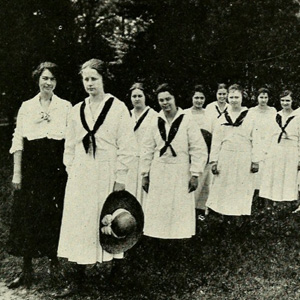Basketball and tennis were the big sports at the Training School, but cross-country walking, or more simply, walking, was the third leg of the athletics stool. While surely good exercise, walking was pushed because of its practicality: no gymnasium was needed, nor expensive equipment. With the outdoors and a few trails or even streets, ECTTS students could take up this physical exercise without further ado. There was also a pedagogical advantage: any school at which Training School students might end up teaching could have its classes engage in cross-country walking. Considerably less outlay was required than for basketball or tennis. Lacking a gym but blessed with abundant natural space and proximate a quiet, small town, the Training School took full advantage of this cost-efficient sports option, making it a core component of its athletic program.
To make the seemingly uninteresting activity more appealing, the Training School Quarterly observed that “even walking” can be made exciting “by giving some motive, such as finding things of interest on the way, seeing who can walk a certain distance in the shortest time, or who can carry himself best.” Another strategy involved organizing cross-country walking teams that in turn competed with one another, much as intramural teams in basketball and tennis competed. Recognizing that trophies stimulated interest and competition, the Athletic League, as of 1915, decided to award cups for walking along with tennis and captain ball. A point system was devised to determine winners. By doing so, walking was put “on a systematic basis” so as to give it “official recognition” as an “out-of-door exercise.”
Walking meant more than just a stroll. The 1914 Training School Quarterly explained that girls in the “Cross-Country Walking Club walk three times a week, the minimum walk being three miles. No credit is given to any girl unless she takes at least twelve walks a year.” That year the club was supervised by Daisey Bailey Waitt, Latin teacher and organizer of the walking club. On one occasion the following year, the walking club took an eight-mile walk, finishing four miles before having a picnic lunch, and then walking another four miles back to the campus. On yet another occasion, the club completed a “three-mile twilight walk after dinner.” However, during WWI, the Athletics League suspended its regular competitions for the sake of cotton-picking, campus cleaning, and tennis-court scraping. Helping with labor problems and the war effort briefly replaced organized athletics. Following the war, organized athletics resumed and walking once more became an integral component of the campus program
Sources
- “Athletic League.” Training School Quarterly. Vol. 5, no. 3. October, November, December, 1918. Raleigh: Edwards & Broughton, 1918. P. 287.
- Comfort, Mabel M. “Organized Out-of-Door Sports.” Training School Quarterly. Vol. 1, no. 4. January, February, March, 1915. Raleigh: Edwards & Broughton, 1915. Pp. 220-223.
- “Play Time.” Training School Quarterly. Vol. 1, no. 4. January, February, March, 1915. Raleigh: Edwards & Broughton, 1915. Pp. 242-243.
- “School Organizations: Athletic League.” Training School Quarterly. Vol. 2, no. 1. April, May, June, 1915. Raleigh: Edwards & Broughton, 1915. P. 67.
- “The Athletic League.” Training School Quarterly. Vol. 1, no. 3. October, November, December, 1914. Raleigh: Edwards & Broughton, 1914. Pp. 181-182.
Citation Information
Title: Cross-Country Walking
Author: John A. Tucker, PhD
Date of Publication: 6/12/2018
